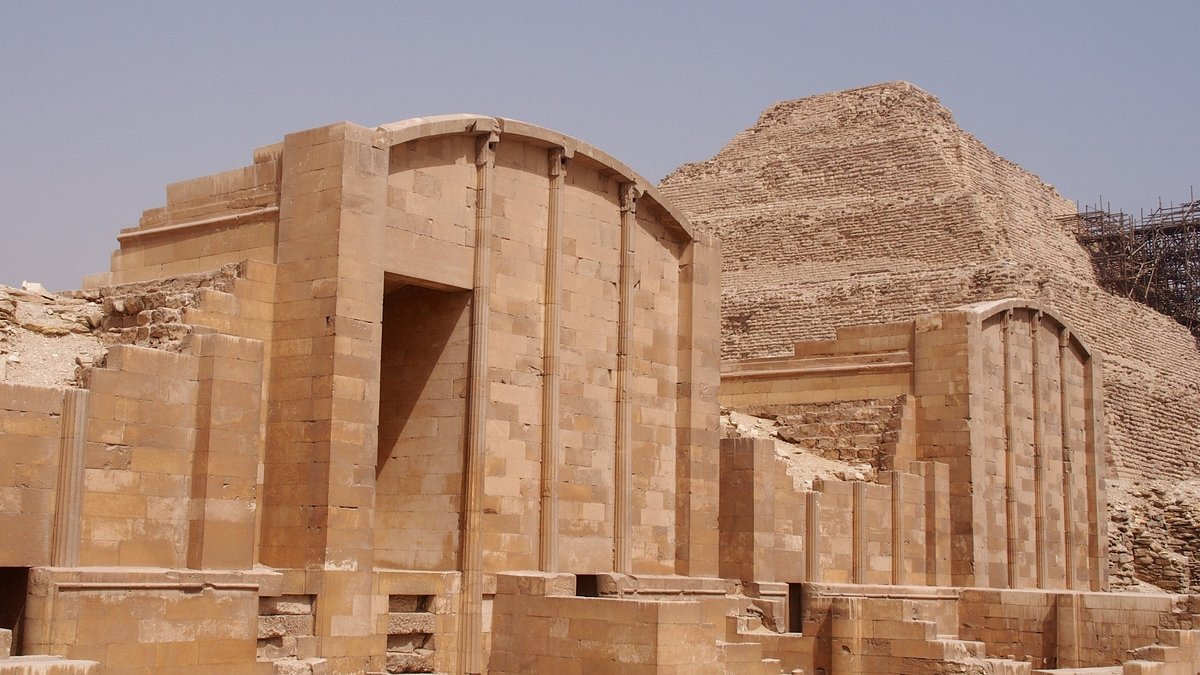Egyptian architecture, with its timeless grandeur, stands as a global symbol of architectural brilliance. Adorned with imposing temples and enduring tombs crafted from stone, these awe-inspiring structures showcase the remarkable legacy of ancient Egypt's architectural prowess.

Following are a few distinctive features of Egyptian architecture:
Egyptian architecture is known for its massive scale, with monuments that dominate the landscape and the skyline.

The Great Pyramid of Giza, built as a tomb for Pharaoh Khufu, is the biggest pyramid in Egypt, standing more than 450 feet tall. Its sheer size and exquisite engineering highlight ancient Egypt's outstanding architectural achievements, leaving visitors in awe at the scale of human achievement.
Egyptian architecture frequently follows a hierarchical planning approach in which spaces and buildings are meticulously placed in a certain order.

The Luxor-based Karnak Temple Complex follows a precise axis, guiding visitors through a series of magnificent entrances and courts, ending in the enormous Hypostyle Hall. This huge hall evokes awe and reverence, exhibiting the intentional arrangement of spaces to underline the significance of the religious rites performed therein.
Symbolism is important in Egyptian architecture, and elaborate ornamental features have profound cultural and religious importance.

The walls and columns of Deir el-Bahari's Temple of Hatshepsut are embellished with magnificently carved reliefs and sculptures showing episodes from Queen Hatshepsut's heavenly birth and triumphant reign as pharaoh.
These creative depictions serve as visually appealing decorations as well as strong narratives about the pharaoh's heavenly position, revealing insights into ancient Egypt's religious beliefs and mythology.
Pylon gates are architectural features of ancient Egyptian temples that are distinguished by their huge, tapering structures with sloping walls.

The Temple of Horus at Edfu's towering gates mark the entry to the temple complex, providing a visually dominating presence and symbolising the shift from the mundane world to the holy realm within. The pylons' wonderfully painted façade, with their detailed reliefs and sculptures, sets the scene for the spiritual trip that visitors take when they enter the temple's interior.
Hypostyle halls, which are roomy areas distinguished by a dense network of columns supporting a big ceiling, are frequently used in Egyptian architecture.

The Temple of Luxor has a magnificent hypostyle hall with 74 huge columns, which creates a spectacular interior area. The towering columns, covered with complex carvings and hieroglyphics, serve not just as structural support but also as a visual spectacle, generating a feeling of majesty and solemnity. These halls were essential to religious events and gatherings, as they could accommodate enormous numbers of people and facilitate communication between the mortal and celestial realms.
Pharaohs were honoured with mortuary temples that functioned as areas of worship and rites.

The Temple of Ramesses II, located on the Nile's banks, is a massive temple with huge statues of Ramesses II and exquisite reliefs depicting his military conquests and divine ancestry. These temples were built to remember the pharaoh's life and assure their immortal legacy, as well as to serve as a location for religious rites and offerings to satisfy the gods and ensure the pharaoh's eternal presence in the afterlife.
The artistry of sunken relief carvings in Egyptian buildings is unparalleled. Images are carved into the surface with this process, providing a shadowy impression.

The exquisite carvings on The Temple of Seti I not only demonstrate the outstanding creative abilities of ancient Egyptian artisans, but they also function as visual tales that tell stories about deities, rites, and historical events. Sunken relief sculptures lend depth and dimension to temple walls, dazzling visitors with their complex intricacies and artistic flair.
Many Egyptian temples include clerestory windows, which are tall windows positioned in the upper section of the walls to provide natural light into the interior.

The windows above the colonnades allow sunlight to enter the temple's sanctuaries and inner chambers. Natural light not only lights religious spaces but also provides an ethereal aura, boosting worshippers' spiritual experiences and emphasising the architectural harmony between light, shadow, and colossal buildings.
Mastabas were rectangular constructions with flat roofs and sloping sides that served as high-ranking officials' tombs.

The Mastaba of Ti, built during the Old Kingdom, is a well-preserved mastaba with typical characteristics such as a tiny chapel for offerings and a burial chamber beneath the superstructure. The basic yet graceful shape of the mastaba symbolises the early phases of Egyptian architectural development, laying the groundwork for the enormous pyramid complexes that would follow.
Obelisks are famous emblems of Egyptian architecture, standing tall and slender with a pyramidal top.

The Luxor Obelisk, currently in Paris, was originally located at the entrance to the Luxor Temple. This obelisk, carved from a single piece of red granite, exemplifies ancient Egypt's extraordinary artistry and technical talents. Obelisks carried symbolic importance, representing the sun's beams and acting as links between the terrestrial and divine realms. The Luxor Obelisk, with its towering height and elaborate hieroglyphic inscriptions, is a tribute to Egyptian architecture's continuing history and impact on global art and design.
Egyptian architecture, with its enormous constructions and symbolic adornments, inspires us to examine the profound links between human existence, spirituality, and the endless desire of immortality. Egyptian architecture tells a philosophical story about human aspirations and the lasting legacy we attempt to leave behind.
